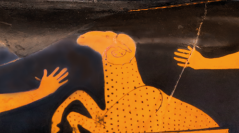

 Anthropozoologica
58 (12) - Pages 115-129
Anthropozoologica
58 (12) - Pages 115-129An article by Michel Pastoureau (2008) laid the foundations for a reflection on the relationship between medieval princely menageries and zoological knowledge, between observation of rare species, verification of ancient legends, scholarly discourse and possible experimentation, relying mainly on the cases of the elephant and the bear. The present article explores the few hypotheses put forward in this study, relying, in addition to the elephant, on the cases of the lion (frequently included in medieval menageries) and the ostrich. For these three species, certain legends, transmitted or not by the Bestiaries, could be invalidated by observation, or even by experiment: the elephants would not have knees; the cubs would be born “dead” and would be “resurrected” after three days; the ostrich would be able to eat metal. Those who observe exotic animals in captivity are divided between two opposing poles: wanting to justify ancient beliefs on the one hand, and contradicting and explaining the errors of the authorities on the other. These observations and possible refutations of ancient legends had only a limited influence on medieval knowledge on exotic animals, particularly in encyclopaedias, but they testify, mainly for the end of the Middle Ages, to a new critical approach in which what was seen had to be assessed from what was known from the texts (and vice versa).
Medieval menageries, natural history, zoological knowledge, elephant, giraffe, ostrich, lion, crocodile.